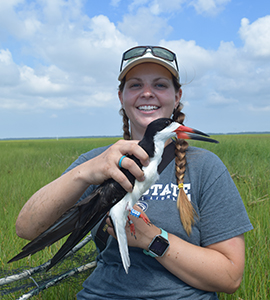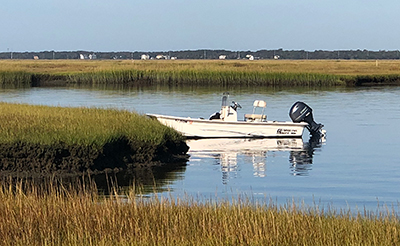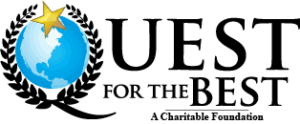Now and Into Our Future, by Dr. Lisa Ferguson
These days at The Wetlands Institute, when we set off to conduct our research, we see the ties to our history in everything around us. From the expansive, green acres of salt marsh that are protected thanks to our founders’ vision and the many individuals who supported this quest; from the 20-year-old diamondback terrapins that live there and continue to inform our broad-reaching research and conservation programs; and from the many people and partners we work with whose roots trace back to their early experiences at The Wetlands Institute – from this vital history and connectivity, we are fortunate to be able to explore questions and make strides in conservation that would be otherwise impossible.
So what are we doing today? To a surprising extent, many of the topics we address in our department now are encapsulated in the 50-year legacy of our research and conservation efforts.
 How do we protect our marshes so they persist in the face of developing and increasing threats? Recently we established an intensive monitoring program to track the long-term changes in our marshes and better understand the frequency of flooding, variations in elevation, and overall marsh condition. Through the formation of Seven Mile Island Living Lab, we are partnering with numerous agencies, universities, and organizations to test new modes for data collection and new approaches for dredge material placement to benefit marshes and the wildlife that depend on them.
How do we protect our marshes so they persist in the face of developing and increasing threats? Recently we established an intensive monitoring program to track the long-term changes in our marshes and better understand the frequency of flooding, variations in elevation, and overall marsh condition. Through the formation of Seven Mile Island Living Lab, we are partnering with numerous agencies, universities, and organizations to test new modes for data collection and new approaches for dredge material placement to benefit marshes and the wildlife that depend on them.
How do we ensure healthy populations of our coastal wildlife? We have reinvigorated our research of coastal birds, using our work to learn more about habitat needs within our barrier island systems, movements both local and long-distance, and techniques for providing safeguards against rising sea levels and habitat loss. For the past six years we have organized the reTURN The Favor program, engaging hundreds of volunteers a year to reduce the loss of horseshoe crabs on the Delaware Bay – to the tune of half a million crabs saved to date – while also identifying hazards in need of mitigation. And using new technologies, we are advancing the tools and knowledge needed to protect diamondback terrapins and other imperiled species.
 How do we ensure the reach of this important work into the future? We continue to focus on scientific training that has been a common thread throughout the history of The Wetlands Institute. Our comprehensive research and conservation programs and proximity to a richness of natural resources present invaluable learning opportunities for curious minds. Each year, we host undergraduate students – tomorrow’s leaders in research, conservation, and education – for a summer of hands-on, personal experience with the scientific process – and some very muddy feet! As a complement to our undergraduate program, and thanks to generous endowed support, we will be initiating a new graduate fellowship program to promote student-led research while expanding our research capacity and fostering new collaborations.
How do we ensure the reach of this important work into the future? We continue to focus on scientific training that has been a common thread throughout the history of The Wetlands Institute. Our comprehensive research and conservation programs and proximity to a richness of natural resources present invaluable learning opportunities for curious minds. Each year, we host undergraduate students – tomorrow’s leaders in research, conservation, and education – for a summer of hands-on, personal experience with the scientific process – and some very muddy feet! As a complement to our undergraduate program, and thanks to generous endowed support, we will be initiating a new graduate fellowship program to promote student-led research while expanding our research capacity and fostering new collaborations.
The Wetlands Institute was founded by a group of people who understood the value of these marshes to all who depend on them and had the vision and drive to protect them. As we look back on our history, we are fortunate to continue the tradition of strategic research projects and comprehensive conservation programs at The Wetlands Institute to ensure this legacy and carry it forward into the next half-century and beyond.
Tracking Terrapins in Our Marshes, by Dr. Lisa Ferguson
 Using new telemetry technology through our partnership with Cellular Tracking Technology, we are beginning to reveal long-sought information about the lives of diamondback terrapins in the marsh. Using size-appropriate Ultra Long Range/GPS tags and digital battery powered radio transmitters, we can track head-started and wild juvenile terrapins to learn more about their movements, behavior, and habitat use. These data provide insights into how terrapins respond to flooding tides, periods of drought, and cooling temperatures, and where they like to spend their time. By continuing this work and tracking young individuals, we will be able to fill gaps in our knowledge of terrapin life history and help inform conservation efforts at The Wetlands Institute and beyond.
Using new telemetry technology through our partnership with Cellular Tracking Technology, we are beginning to reveal long-sought information about the lives of diamondback terrapins in the marsh. Using size-appropriate Ultra Long Range/GPS tags and digital battery powered radio transmitters, we can track head-started and wild juvenile terrapins to learn more about their movements, behavior, and habitat use. These data provide insights into how terrapins respond to flooding tides, periods of drought, and cooling temperatures, and where they like to spend their time. By continuing this work and tracking young individuals, we will be able to fill gaps in our knowledge of terrapin life history and help inform conservation efforts at The Wetlands Institute and beyond.
We are also tracking adult female terrapins within the marsh, producing some first-of-its-kind data for the species. With the tracking devices we have been able to document eight terrapins on probable nest attempts and directly observe four transmitter-equipped females nesting. Up to three times a season, these data tell us how terrapins travel between nesting visits. The project is increasing our understanding of terrapin movements and home range size, as well as basking and nesting behavior.
We are excited to continue this investment in research, and for the great opportunity it presents for The Wetlands Institute to exhibit our expertise and advance the research and conservation of diamondback terrapins and other species of interest. Thanks to the supporters of this project, including Franklin Parker Conservation Grant, The Leff Family Foundation, Quest for the Best Foundation, and the Davenport Family Foundation.
Grants and Gifts Keep The Wetlands Institute Projects Afloat
We are pleased to announce that The Wetlands Institute received an emergency funds grant from Quest for the Best to purchase a new 16’ Carolina skiff and trailer. We also received a generous donation from Julian and Betsy Miraglia to cover expenses for fiberglass repairs and a new engine for our workhorse 16’ skiff. We rely on these boats for so much of our work, and are grateful to have new and improved vessels that can reliably support our on-the-water research and conservation programs that include marsh monitoring programs, research on beneficial use of dredge materials, colonial bird use of elevated nesting habitats, diamondback terrapin population studies and telemetry work, and wave and current studies of the back bays. Thanks so much to these supporters.
 |
 |
